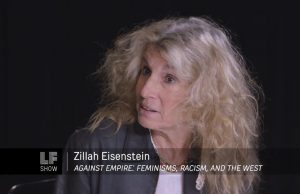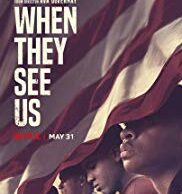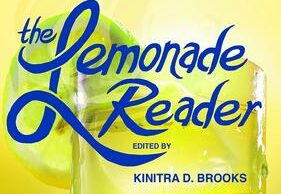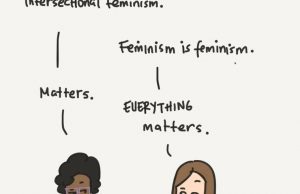Towards An Abolitionist Feminism
By Zillah Eisenstein
As an anti-racist white feminist, I wonder if it is enough to be an “ally” in this present and “newest” moment of racist/militarist/carceral violence. Or, is there something more to do? I am thinking hard about this “newness,” which is also very old.
White anti-racist feminists can take the lead from our Black and Brown sisters and embrace an abolitionist stance towards chattel slavery and its racist and misogynist remains. Such an abolitionist feminism must commit to abolishing all forms of racial and sexual violence along with the hierarchies of economic class and hetero-patriarchy in their white privileged forms.
If I had lived during chattel slavery, I would have been an activist abolitionist feminist. Today, I/we need an activist abolitionist feminism focused on ending the hetero-patriarchal capitalist racist police state.
I used to be grateful that I did not live during institutionalized and legal chattel slavery. Instead, I was raised by Communist parents whose entire beings were committed to an ending of Jim Crow law. As a child I participated in picket lines and the civil rights movement. Laws were then changed; and it was now easier to fool yourself, especially if you are white, that racism had ended. Actually, racism got more complicated, more extra-legal, and more insidious.
On Being White
I am not sure James Baldwin is nuanced enough when he says that being white is an attitude more than a color—that you are as white as you think you are and therefore it is a choice; and that for Blacks their color is a “condition,” and not a choice. But I like the lack of equivalence, making whiteness a choice, and that whites have an added responsibility for the times “we” ALL live in. What does this mean for white anti-racist/abolitionist feminists?
It means challenging white privilege at the core of everything while being white. Otherwise, I/we walk around enforcing the white racist hetero-patriarchal capitalist state, privileging its whiteness. This is where white “choice” comes in.
I could not begin to ask these questions if I had not been in the struggle for years with Black feminists, side by side—when the white women’s movement was being openly and doggedly indicted for its racism. bell hooks, and Angela Davis, and Barbara Smith, and Audre Lorde, and Hortense Spillers, and Beverly Guy-Sheftall were part of my earliest anti-racist feminist experience and work. I continue to learn more recently with and from Brittney Cooper, and Tamura Lomax, and Aishah Shahidah Simmons, and Salamishah Tillet, and from Black Lives Matter hashtag founders Alicia Garza, Patrisse Cullors, and Opal Tometi, to name just a few.
So I tell myself to not “be/act white” and use this privilege of “choice” to help make a revolution that is structural but also an individual affair. If Franz Fanon and Frank Wilderson are right, and white people function in their own corporeality as deputies of the state, we must destroy this unauthorized “deputization” that is as misogynist as it is white privileged.
“New-Old” and “Newest-New” Racism
I use the phrase “newest–new” racism to call attention to the fact that violence towards Blacks has a too-long history. Everything new is also old, and yet not the same, even if similar. The “newest-new” of racism replaces homogeneity with complexity, and fluidity, and modernization of the slave relation itself. Black slavery, as Saidiya Hartman would have it, was an ultimate form of dehumanization and severing of people from their family, especially their mothers, and their sense of place. Although racism is no longer articulated in a system of chattel slavery, it is enforced through a prison/police state of carceral punishment that has shattering likenesses to the slave system.
Whiteness as it exists still makes being Black irreconcilable with safety and possibility. Afro-pessimists like Wilderson see the continual dispossession of Black life; Jared Sexton calls this hatred of Blackness “captive flesh”; Hortense Spillers writes of the Black woman’s body as a “hieroglyphics of the flesh.” And yet, Blackness remains captive but defiant in #BlackLivesMatter and #KnowHerName.
Saidiya Hartman writes that she is living in “an afterlife of slavery” and in a “future created by slavery.” She reminds us to remember “the present was created by people in chains” so that “slavery feels proximate rather than remote.”
Freddie Gray’s killing by Baltimore police harkens back to this past. His neck was broken. He was killed with no “trial, without a jury, without a sentence.” State Prosecutor Marilyn Mosby determined that the arrest was illegal at the start. Former Black Panther Eddie Conway says that the police were a lynch mob. “There was a body, and no trial, but rather an execution.” This was a modern day carceral lynching, in its newest form.
Slavery exists in its “new-old “ and “newest-new” form in the prison system today. Black captive bodies reside here in similar and also in different fashion, but the dehumanization that is/was essential to chattel slavery remains in its more modernized form. It is interesting that the capitalism of today, which is very differently formed than its early beginning, is still named capitalism. Patriarchy, as well, no longer resides in most of its earliest legal forms, but still retains its name. Yet, although there are new forms of slavery and lynching, these names are not readily applied to their more recent incarnations. There is continuity and restructuring here to be recognized in this present moment of neo-liberal misogynist racist slavery.
The “Newest” New-Old Slavery
The violence today towards Blacks has new publicity. The violence itself is not new. The history is a continuance. The murders of Oscar Grant, Trayvon Martin, Michael Brown, Eric Garner, Tamir Rice exposed police violence anew before the more recent killing of Freddie Gray. The present noise often inadvertently silences other recent violences: towards Abner Louima, Rodney King, the Black teenagers falsely incarcerated for rape in the “notorious” Central Park 5; not to mention the more recent egregious jailing and beating of Kalief Browder, a young Black teenager jailed and beaten for three years in Rikers Island with no trial.
Structural/institutional racism is the problem, but is not specific enough to clarify the meaning of the particularly racist-structural relations of today. The knowing and really caring is in the details. Mass incarceration and carceral expansionism locate the new racism within much of the civil rights legislation that was meant to address racial inequality. Instead, according to Naomi Muakawa, the present/new police state grew out of the criminalization of the “race” problem. Bill Clinton was a recent architect.
White Anti-Racists Against White Misogynist Privilege
Racism is as intimately patriarchal as it is race based. Reproductive rights are not color specific. Each and every woman of every color needs to be able to determine her own body. Yet, the mobilization against racism assumes Blacks are men. Barbara Smith decades ago spoke to the problem that: “All the Men are Black, All the Women are White, and some of Us are Brave.” Misogyny assists the killing of all people, with no accountability.
Militarized policing focuses an unrelenting surveillance of Black bodies, especially Black boys and young men. They are criminalized and in part killed because of a hyper-sexualized fear of Black maleness. But Black women’s bodies are also surveilled and beaten and raped and incarcerated in disproportionate numbers to white women.
However, racism also has new complexity. White privilege has learned how to be more flexible than during chattel slavery. The present feels both really different from the past and also too similarly tied to it. So the present is a way of seeing and knowing with a connection to this erasure, re-wiring, redefinition of slave life.
There is a new visibility of Black women with Michelle Obama as first lady, and Loretta Lynch as the new Attorney General, and Stephanie Rawlings-Blake in Baltimore as mayor, and Marilyn Mosby as the key prosecutorial state attorney. There is no simple inside/outside as new “colored” identities and borders are crossed. This visibility contrasts deeply with the invisibility of the Black and Brown women who are disproportionately beaten, raped, killed, and incarcerated.
There is supposedly new accountability and transparency with a Black president and new technological capacity, through cell phone cameras exposing police violations. And yet, there is the concentrated one percent and condensed and concentrated power that curtails resistance and insurgency. The established borders of inside/outside that denote the notions of reform and revolution need reimagining. Even though her spirit remains with us, it would be wonderful if Audre Lorde were here to talk about the “masters tools.”
#Black Women/Trans/Gays Matter
The new slavery, the “newest new racism,” demands a more complex resistance because the problem is complexly layered and in contradictory fashion. Misogyny still masquerades within the anti-racist rhetoric. Rekia Boyd, Natasha McKenna, Yvette Smith, Miriam Carey, Shelly Frey, Darnisha Harris, and Tanisha Anderson are black women who have died at the hands of police. Yet, there are no marches in their name. No media coverage or anger/resistance/outcry. There is a silence about these deaths of young women. Yet twenty percent of unarmed Blacks killed in the last fifteen years by police are black women.
Their lives matter. Like the Combahee River Collective said all those years ago, in Boston during the serial killings and rapes of Black women — they died because they were women and black. Sexual violence and rape are the more usual forms of racist treatment of Black and brown women. Marissa Alexander was jailed for defending herself against an abusive husband, as are countless women in domestic abuse situations. And accused serial “rapist” police officer Daniel Holtzclaw has continued to escape the media limelight.
Black women are the fastest growing segment of the prison population. Black and Latina women are suspended from school at a higher rate than white women. They are also murdered and unemployed at higher rates. Without dealing with racism, misogyny stays in place, and without attacking misogyny racism marches on. Police violence, sexual violence, and domestic violence are implicated with each other, as are racism and misogyny in their different class configurations.
The Filtering of Race Through Gender…
The new resistance and organized movement(s) of Black men and women are more inclusive and radical than earlier leaderships in the 1960s and 1970s civil rights movement. This may in part be because racism itself has become more exposed in its complex forms. The leadership of Black Lives Matter, Million Hoodies, Hands Up United, Dream Defenders, etc. is staffed with people of all genders and sexual orientations.
I think it is especially important for white anti-racist feminists to have the backs of our Black and Brown sisters, especially in this moment. Kimberle Crenshaw and her leadership with the African American Policy Forum (AAPF) have been relentless in bringing an inclusive view of anti-racist work to include Black women. They have critiqued and re-imagined Obama’s initiative of “My Brothers Keeper” (MBK) to address the needs of Black and Brown girls of color as well as boys. Racism cannot be fully addressed with the exclusion of Black girls and women.
Black women’s lives have been silenced when chattel slavery is described singularly as a racist system, rather than as intimately sexual as well. Chattel slavery was a racial and sexual system of exploitation, brutalization, and oppression. Slavery today remains implicated in both racism and misogyny. Its intimate “intersectional” relationship continues through new, more present forms. Patriarchy, for Black women may liken them to white women, as in less dangerous than Black men. But racism is not exclusive according to gender; it is filtered through it. If racism is to be fully addressed, a specific yet shared focus across male and female borders is needed.
So, “we”—white anti-racist feminists—must stand in support of our sisters of color against the brutalization of Black male bodies while also standing with them against their own invisibility. To keep Black women invisible is to assist the patriarchal and misogynist support systems of racism. White masculinity, militarism, and misogyny prop up racism.
Racism should not be allowed to make the sexism in/and/of racism silenced or ignored. To do so makes Black women invisible in both the practices and resistance to racism. As white anti-racist feminists, we must stand with our sisters of color exposing, not allowing, not “choosing” our own white privilege by being close, really close—in neighborhoods, schools, parks, restaurants—everywhere, to Black and Brown lives that always matter. And then to be ready to abolish racism and misogyny by redistributing white wealth through a (tax) system of reparations that will rebuild infrastructures of everyday life in communities of color.
So, I am not sure being an ally asks enough of us. It might not be getting close enough to our Black and Brown sisters, or our own whiteness.
#Know Her Name, #We Can’t Wait, #Say Her Name, #Black Girls Matter, #Her Dream Deferred
And:
#Hands Up/Don‘t Shoot, #Hands off/Don’t Rape, #White Abolitionist Feminists For All Black Lives
 Zillah Eisenstein has been a Professor of Politics at Ithaca College in New York for the past 35 years and is now “Distinguished Scholar in Residence” there. Besides her recently published THE AUDACITY OF RACES AND GENDERS: A PERSONAL AND GLOBAL STORY OF THE OBAMA CAMPAIGN (2009, Zed Press, London; Palgrave, U.S.), her books include among others: SEXUAL DECOYS, GENDER, RACE AND WAR IN IMPERIAL DEMOCRACY (London, Zed Press; New York, Palgrave, 2007); AGAINST EMPIRE, ibid.; HATREDS: RACIALISED AND SEXUALIZED CONFLICTS IN THE 21ST CENTURY, (Routledge, 1996); GLOBAL OBSCENTITIES: PATRIARCHY, CAPITALISM AND THE LURE OF CYBERFANTASY (NYU PRESS, 1996); and MANMADE BREAST CANCERS, (Cornell Univ. Press, 2001). For more information see: www.ithaca.edu/zillah.
Zillah Eisenstein has been a Professor of Politics at Ithaca College in New York for the past 35 years and is now “Distinguished Scholar in Residence” there. Besides her recently published THE AUDACITY OF RACES AND GENDERS: A PERSONAL AND GLOBAL STORY OF THE OBAMA CAMPAIGN (2009, Zed Press, London; Palgrave, U.S.), her books include among others: SEXUAL DECOYS, GENDER, RACE AND WAR IN IMPERIAL DEMOCRACY (London, Zed Press; New York, Palgrave, 2007); AGAINST EMPIRE, ibid.; HATREDS: RACIALISED AND SEXUALIZED CONFLICTS IN THE 21ST CENTURY, (Routledge, 1996); GLOBAL OBSCENTITIES: PATRIARCHY, CAPITALISM AND THE LURE OF CYBERFANTASY (NYU PRESS, 1996); and MANMADE BREAST CANCERS, (Cornell Univ. Press, 2001). For more information see: www.ithaca.edu/zillah.





Pingback: Towards an Abolitionist Feminism | Zillah Eisenstein
Pingback: Black Women’s Lives Don’t Matter in Academia Either, or Why I Quit Academic Spaces that Don’t Value Black Women’s Life and Labor - The Feminist Wire | The Feminist Wire
Pingback: Towards An Abolitionist Feminism - Zillah Eisenstein - Progressive Radio Network
Pingback: tamura a. lomax, “black women’s lives don’t matter in academic either” | academic abolitionism
Pingback: tamura a. lomax, “black women’s lives don’t matter in academia either” | academic abolitionism